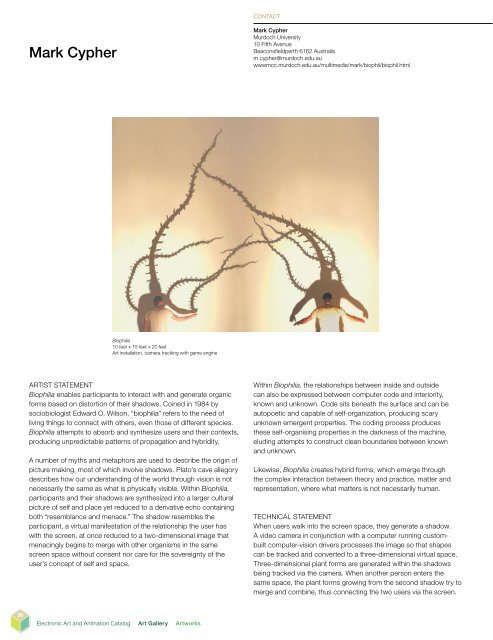Intersections - Nguyen Dang Binh
Intersections - Nguyen Dang Binh
Intersections - Nguyen Dang Binh
You also want an ePaper? Increase the reach of your titles
YUMPU automatically turns print PDFs into web optimized ePapers that Google loves.
Mark Cypher<br />
Biophilia<br />
10 feet x 15 feet x 20 feet<br />
Art installation, camera tracking with game engine<br />
ARTIST STATEMENT<br />
Biophilia enables participants to interact with and generate organic<br />
forms based on distortion of their shadows. Coined in 1984 by<br />
sociobiologist Edward O. Wilson, “biophilia” refers to the need of<br />
living things to connect with others, even those of different species.<br />
Biophilia attempts to absorb and synthesize users and their contexts,<br />
producing unpredictable patterns of propagation and hybridity.<br />
A number of myths and metaphors are used to describe the origin of<br />
picture making, most of which involve shadows. Plato’s cave allegory<br />
describes how our understanding of the world through vision is not<br />
necessarily the same as what is physically visible. Within Biophilia,<br />
participants and their shadows are synthesized into a larger cultural<br />
picture of self and place yet reduced to a derivative echo containing<br />
both “resemblance and menace.” The shadow resembles the<br />
participant, a virtual manifestation of the relationship the user has<br />
with the screen, at once reduced to a two-dimensional image that<br />
menacingly begins to merge with other organisms in the same<br />
screen space without consent nor care for the sovereignty of the<br />
user’s concept of self and space.<br />
Electronic Art and Animation Catalog Art Gallery Artworks<br />
CONTACT<br />
Mark Cypher<br />
Murdoch University<br />
10 Fifth Avenue<br />
Beaconsfieldperth 6162 Australia<br />
m.cypher@murdoch.edu.au<br />
wwwmcc.murdoch.edu.au/multimedia/mark/biophil/biophil.html<br />
Within Biophilia, the relationships between inside and outside<br />
can also be expressed between computer code and interiority,<br />
known and unknown. Code sits beneath the surface and can be<br />
autopoetic and capable of self-organization, producing scary<br />
unknown emergent properties. The coding process produces<br />
these self-organising properties in the darkness of the machine,<br />
eluding attempts to construct clean boundaries between known<br />
and unknown.<br />
likewise, Biophilia creates hybrid forms, which emerge through<br />
the complex interaction between theory and practice, matter and<br />
representation, where what matters is not necessarily human.<br />
TECHNICAl STATEMENT<br />
When users walk into the screen space, they generate a shadow.<br />
A video camera in conjunction with a computer running custombuilt<br />
computer-vision drivers processes the image so that shapes<br />
can be tracked and converted to a three-dimensional virtual space.<br />
Three-dimensional plant forms are generated within the shadows<br />
being tracked via the camera. When another person enters the<br />
same space, the plant forms growing from the second shadow try to<br />
merge and combine, thus connecting the two users via the screen.

















